Long-Term Variation of Black Carbon Aerosol in China Based on Revised Aethalometer Monitoring Data
Abstract
1. Introduction
2. Data and Methods
3. Results
3.1. Average BC Concentration and its Proportion in PM2.5
3.2. Seasonal Variation of BC Aerosol
3.3. Interannual Variation of BC Concentration
3.4. Diurnal Variation of BC Concentration
3.5. Data Differences Before and after Revision
4. Conclusions
Author Contributions
Funding
Acknowledgments
Conflicts of Interest
Appendix A
| No. | Abbreviation 1 | Full Name |
|---|---|---|
| 1 | AE-31 | Aethalometer-31 |
| 2 | Aes | Aethalometer instruments |
| 3 | ATN | The attenuation of light |
| 4 | BC | Black carbon |
| 5 | CAWNET | China Atmosphere Watch Network |
| 6 | CMA | China Meteorological Administration |
| 7 | EC | Element carbon |
| 8 | MAAP | Multi-angle Absorption Photometer |
| 9 | MEIC | Multi-resolution Emission Inventory for China |
| 10 | OC | Organic carbon |
| 11 | PSAP | Particle Soot Absorption Photometer |
| 12 | SMPS | Scanning Mobility Particle Sizer |
| 13 | SP2 | Single Particle Soot Photometer |
| 14 | TOR | The thermal/optical reflectance method |
References
- Cape, J.N.; Coyle, M.; Dumitrean, P. The atmospheric lifetime of black carbon. Atmos. Environ. 2012, 59, 256–263. [Google Scholar] [CrossRef]
- Drinovec, L.; Gregoric, A.; Zotter, P.; Wolf, R.; Anne Bruns, E.; Bruns, E.A.; Prevot, A.S.H.; Favez, O.; Sciare, J.; Arnold, I.J.; et al. The filter-loading effect by ambient aerosols in filter absorption photometers depends on the coating of the sampled particles. Atmos. Meas. Tech. 2017, 10, 1043–1059. [Google Scholar] [CrossRef]
- Jacobson, J.Z. Strong radiative heating due to the mixing of black carbon in atmospheric aerosols. Nature 2001, 409, 695–697. [Google Scholar] [CrossRef] [PubMed]
- Hansen, J.; Nazarenko, L. Soot climate forcing via snow and ice albedos. Proc. Natl. Acad. Sci. USA 2004, 101, 423–428. [Google Scholar] [CrossRef]
- Huang, L.; Gong, S.L.; Sharma, S.; Lavoué, D.; Jia, C.Q. A trajectory analysis of atmospheric transport of black carbon aerosols to Canadian high Arctic in winter and spring (1990–2005). Atmos. Chem. Phys. 2010, 10, 5065–5073. [Google Scholar] [CrossRef]
- Flanner, M.G.; Zender, C.S.; Randerson, J.T.; Rasch, P.J. Present-day climate forcing and response from black carbon in snow. J. Geophys. Res. Atmos. 2007, 112, 1–17. [Google Scholar] [CrossRef]
- Peng, J.; Hu, M.; Guo, S.; Du, Z.; Zheng, J.; Shang, D.; Zamora, M.L.; Zeng, L.; Shao, M.; Wu, Y.S.; et al. Markedly enhanced absorption and direct radiative forcing of black carbon under polluted urban environments. Proc. Natl. Acad. Sci. USA 2016, 113, 4266–4271. [Google Scholar] [CrossRef]
- Rana, A.; Jia, S.; Sarkar, S. Black carbon aerosol in India: A comprehensive review of current status and future prospects. Atmos. Res. 2019, 218, 207–230. [Google Scholar] [CrossRef]
- Monge, M.E.; D’Anna, B.; Mazri, L.; Giroir-Fendler, A.; Ammann, M.; Donaldson, D.J.; George, C. Light changes the atmospheric reactivity of soot. Proc. Natl. Acad. Sci. USA 2010, 107, 6605–6609. [Google Scholar] [CrossRef]
- Fu, T.M.; Cao, J.J.; Zhang, X.Y.; Lee, S.C.; Zhang, Q.; Han, Y.M.; Qu, W.J.; Han, Z.; Zhang, R.; Wang, Y.X.; et al. Carbonaceous aerosols in China: Top-down constraints on primary sources and estimation of secondary contribution. Atmos. Chem. Phys. 2012, 12, 2725–2746. [Google Scholar] [CrossRef]
- Vaishya, A.; Singh, P.; Rastogi, S.; Babu, S.S. Aerosol black carbon quantification in the central Indo-Gangetic Plain: Seasonal heterogeneity and source apportionment. Atmos. Res. 2017, 185, 13–21. [Google Scholar] [CrossRef]
- Rajesh, T.A.; Ramachandran, S. Black carbon aerosols over urban and high altitude remote regions: Characteristics and radiative implications. Atmos. Environ. 2018, 194, 110–122. [Google Scholar] [CrossRef]
- Prasad, P.; Roja Raman, M.; Venkat Ratnam, M.; Chen, W.N.; Vijaya Bhaskara Rao, S.; Gogoi, M.M.; Kompalli, S.K.; Sarat Kumar, K.; Suresh Babu, S. Characterization of atmospheric Black Carbon over a semi-urban site of Southeast India: Local sources and long-range transport. Atmos. Res. 2018, 213, 411–421. [Google Scholar] [CrossRef]
- Tan, H.; Liu, L.; Fan, S.; Li, F.; Yin, Y.; Cai, M.; Chan, P.W. Aerosol optical properties and mixing state of black carbon in the Pearl River Delta, China. Atmos. Environ. 2016, 131, 196–208. [Google Scholar] [CrossRef]
- Li, L.; Che, H.; Derimian, Y.; Dubovik, O.; Schuster, G.L.; Chen, C.; Li, Q.; Wang, Y.; Guo, B.; Zhang, X. Retrievals of fine mode light-absorbing carbonaceous aerosols from POLDER/PARASOL observations over East and South Asia. Remote Sens. Environ. 2020, 247, 111913. [Google Scholar] [CrossRef]
- Li, L.; Dubovik, O.; Derimian, Y.; Schuster, G.L.; Lapyonok, T.; Litvinov, P.; Ducos, F.; Fuertes, D.; Chen, C.; Li, Z.; et al. Retrieval of aerosol components directly from satellite and ground-based measurements. Atmos. Chem. Phys. 2019, 19, 13409–13443. [Google Scholar] [CrossRef]
- Saturno, J.; Pöhlker, C.; Massabò, D.; Brito, J.; Carbone, S.; Cheng, Y.; Chi, X.; Ditas, F.; Hrab De Angelis, I.; Morán-Zuloaga, D.; et al. Comparison of different Aethalometer correction schemes and a reference multi-wavelength absorption technique for ambient aerosol data. Atmos. Meas. Tech. 2017, 10. [Google Scholar] [CrossRef]
- Massabò, D.; Caponi, L.; Bove, M.C.; Prati, P. Brown carbon and thermal-optical analysis: A correction based on optical multi-wavelength apportionment of atmospheric aerosols. Atmos. Environ. 2016, 125, 119–125. [Google Scholar] [CrossRef]
- Wang, Q.Y.; Huang, R.J.; Cao, J.J.; Tie, X.X.; Ni, H.Y.; Zhou, Y.Q.; Han, Y.M.; Hu, T.F.; Zhu, C.S.; Feng, T.; et al. Black carbon aerosol in winter northeastern Qinghai-Tibetan Plateau, China: The source, mixing state and optical property. Atmos. Chem. Phys. 2015, 15, 13059–13069. [Google Scholar] [CrossRef]
- Shan, T. One-Year Measurements of Equivalent Black Carbon, Optical Properties, and Sources in the Urumqi River. Atmosphere 2020, 11, 478. [Google Scholar] [CrossRef]
- Allen, G.A.; Lawrence, J.; Koutrakis, P. Field validation of a semi-continuous method for aerosol black carbon (Aethalometer) and temporal patterns of summertime hourly black carbon measurements in southwestern PA. Atmos. Environ. 1999, 33, 817–823. [Google Scholar] [CrossRef]
- Zhang, X.Y.; Wang, Y.Q.; Zhang, X.C.; Guo, W.; Niu, T.; Gong, S.L.; Yin, Y.; Zhao, P.; Jin, J.L.; Yu, M. Aerosol monitoring at multiple locations in China: Contributions of EC and dust to aerosol light absorption. Tellus B Chem. Phys. Meteorol. 2008, 60, 647–656. [Google Scholar] [CrossRef]
- Weingartner, E.; Saathoff, H.; Schnaiter, M.; Streit, N.; Bitnar, B.; Baltensperger, U. Absorption of light by soot particles: Determination of the absorption coefficient by means of aethalometers. J. Aerosol Sci. 2003, 34, 1445–1463. [Google Scholar] [CrossRef]
- Arnott, W.P.; Hamasha, K.; Moosmüller, H.; Sheridan, P.J.; Ogren, J.A. Towards aerosol light-absorption measurements with a 7-wavelength aethalometer: Evaluation with a photoacoustic instrument and 3-wavelength nephelometer. Aerosol Sci. Technol. 2005, 39, 17–29. [Google Scholar] [CrossRef]
- Park, S.S.; Hansen, A.D.A.; Cho, S.Y. Measurement of real time black carbon for investigating spot loading effects of Aethalometer data. Atmos. Environ. 2010, 44, 1449–1455. [Google Scholar] [CrossRef]
- Virkkula, A.; Mäkelä, T.; Hillamo, R.; Yli-Tuomi, T.; Hirsikko, A.; Hämeri, K.; Koponen, I.K. A simple procedure for correcting loading effects of aethalometer data. J. Air Waste Manag. Assoc. 2007, 57, 1214–1222. [Google Scholar] [CrossRef] [PubMed]
- Schmid, O.; Artaxo, P.; Arnott, W.P.; Chand, D.; Gatti, L.V.; Frank, G.P.; Hoffer, A.; Schnaiter, M.; Andreae, M.O. Spectral light absorption by ambient aerosols influenced by biomass burning in the Amazon Basin. I: Comparison and field calibration of absorption measurement techniques. Atmos. Chem. Phys. 2006, 6, 3443–3462. [Google Scholar] [CrossRef]
- Collaud Coen, M.; Weingartner, E.; Apituley, A.; Ceburnis, D.; Fierz-Schmidhauser, R.; Flentje, H.; Henzing, J.S.; Jennings, S.G.; Moerman, M.; Petzold, A.; et al. Minimizing light absorption measurement artifacts of the Aethalometer: Evaluation of five correction algorithms. Atmos. Meas. Tech. 2010, 3, 457–474. [Google Scholar] [CrossRef]
- Cao, J.; Zhu, C.; Ho, K.; Han, Y.; Shen, Z.; Zhan, C.; Zhang, J. Light attenuation cross-section of black carbon in an urban atmosphere in northern China. Particuology 2015, 18, 89–95. [Google Scholar] [CrossRef]
- Zhang, Y.; Li, Y.; Guo, J.; Wang, Y.; Chen, D.; Chen, H. The climatology and trend of black carbon in China from 12-year ground observations. Clim. Dyn. 2019, 53, 5881–5892. [Google Scholar] [CrossRef]
- Zhang, X.Y.; Wang, Y.Q.; Niu, T.; Zhang, X.C.; Gong, S.L.; Zhang, Y.M.; Sun, J.Y. Atmospheric aerosol compositions in China: Spatial/temporal variability, chemical signature, regional haze distribution and comparisons with global aerosols. Atmos. Chem. Phys. 2012, 779–799. [Google Scholar] [CrossRef]
- Wang, Q.; Huang, R.J.; Cao, J.; Han, Y.; Wang, G.; Li, G.; Wang, Y.; Dai, W.; Zhang, R.; Zhou, Y. Mixing state of black carbon aerosol in a heavily polluted urban area of China: Implications for light absorption enhancement. Aerosol Sci. Technol. 2014, 48, 689–697. [Google Scholar] [CrossRef]
- Kondo, Y.; Sahu, L.; Kuwata, M.; Miyazaki, Y.; Takegawa, N.; Moteki, N.; Imaru, J.; Han, S.; Nakayama, T.; Oanh, N.T.K.; et al. Stabilization of the mass absorption cross section of black carbon for filter-based absorption photometry by the use of a heated inlet. Aerosol Sci. Technol. 2009, 43, 741–756. [Google Scholar] [CrossRef]
- Wang, Y.Q.; Zhang, X.Y.; Sun, J.Y.; Zhang, X.C.; Che, H.Z.; Li, Y. Spatial and temporal variations of the concentrations ofPM10, PM2.5 and PM1 in China. Atmos. Chem. Phys. 2015, 15, 15319–15354. [Google Scholar] [CrossRef]
- Li, M.; Liu, H.; Geng, G.; Hong, C.; Liu, F.; Song, Y.; Tong, D.; Zheng, B.; Cui, H.; Man, H.; et al. Anthropogenic emission inventories in China: A review. Natl. Sci. Rev. 2017, 4, 834–866. [Google Scholar] [CrossRef]
- Multi Resolution Emission Inventory for China. Available online: http://www.meicmodel.org (accessed on 27 June 2020).
- Stabile, L.; Fuoco, F.C.; Buonanno, G. Characteristics of particles and black carbon emitted by combustion of incenses, candles and anti-mosquito products. Build. Environ. 2012, 56, 184–191. [Google Scholar] [CrossRef]
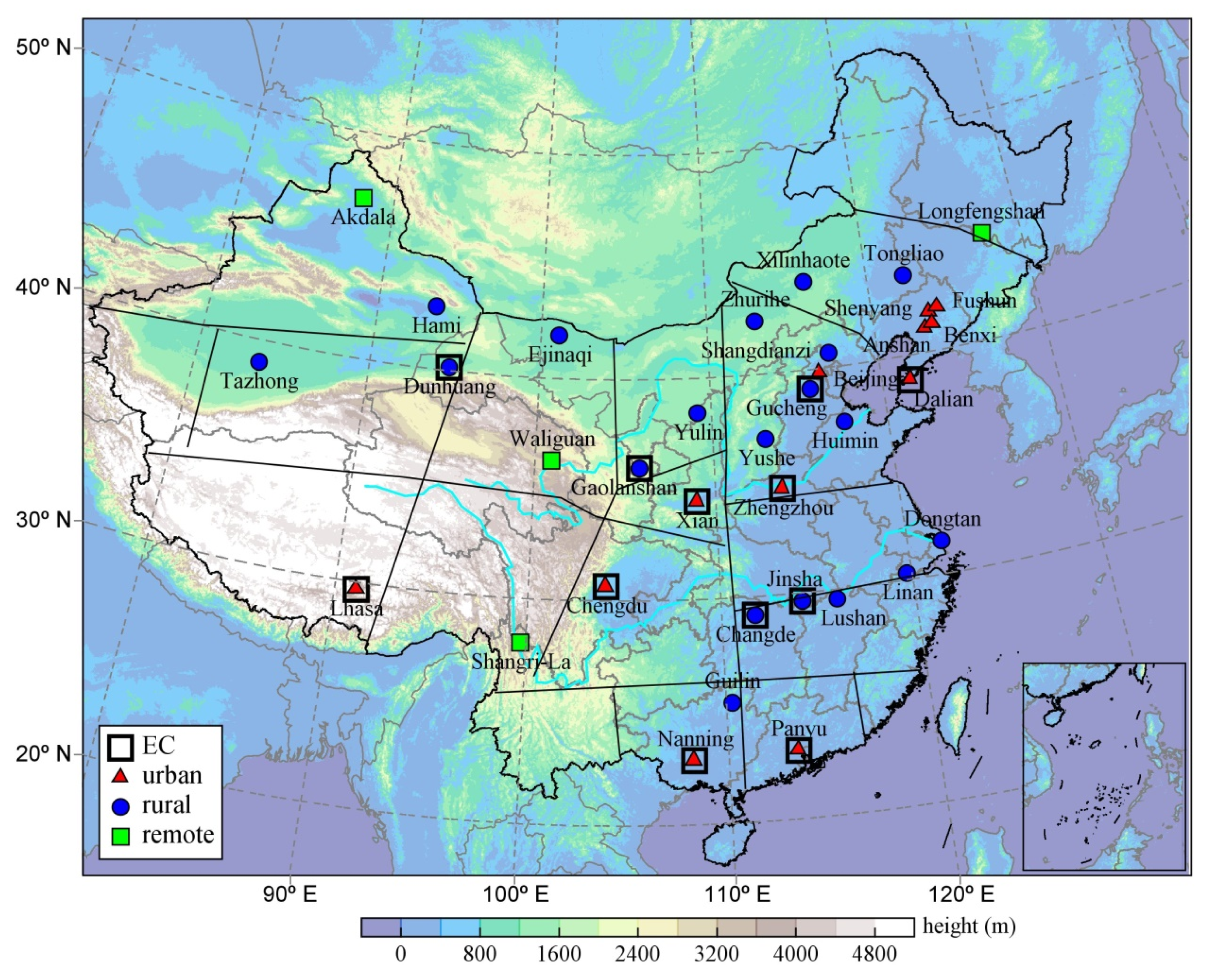

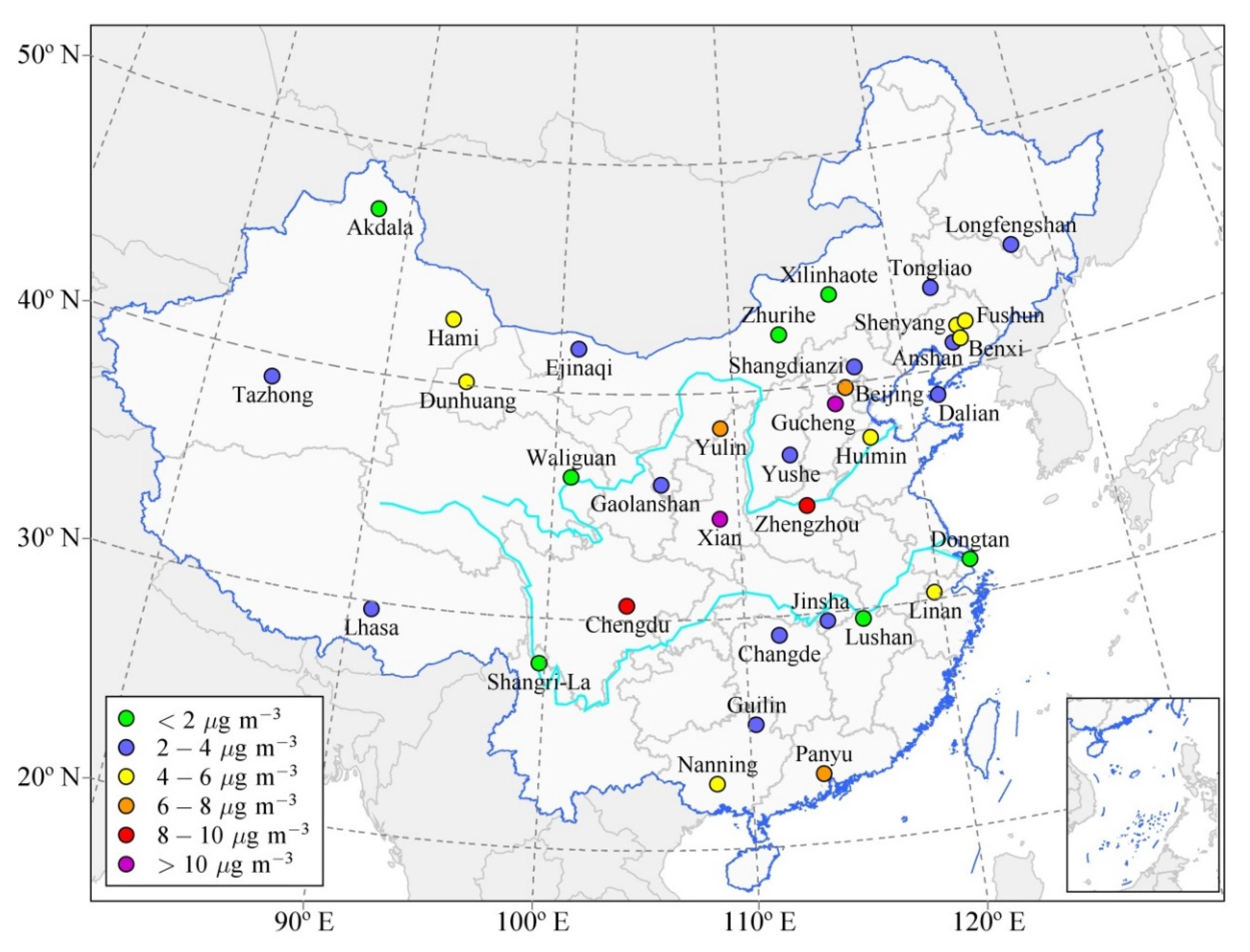
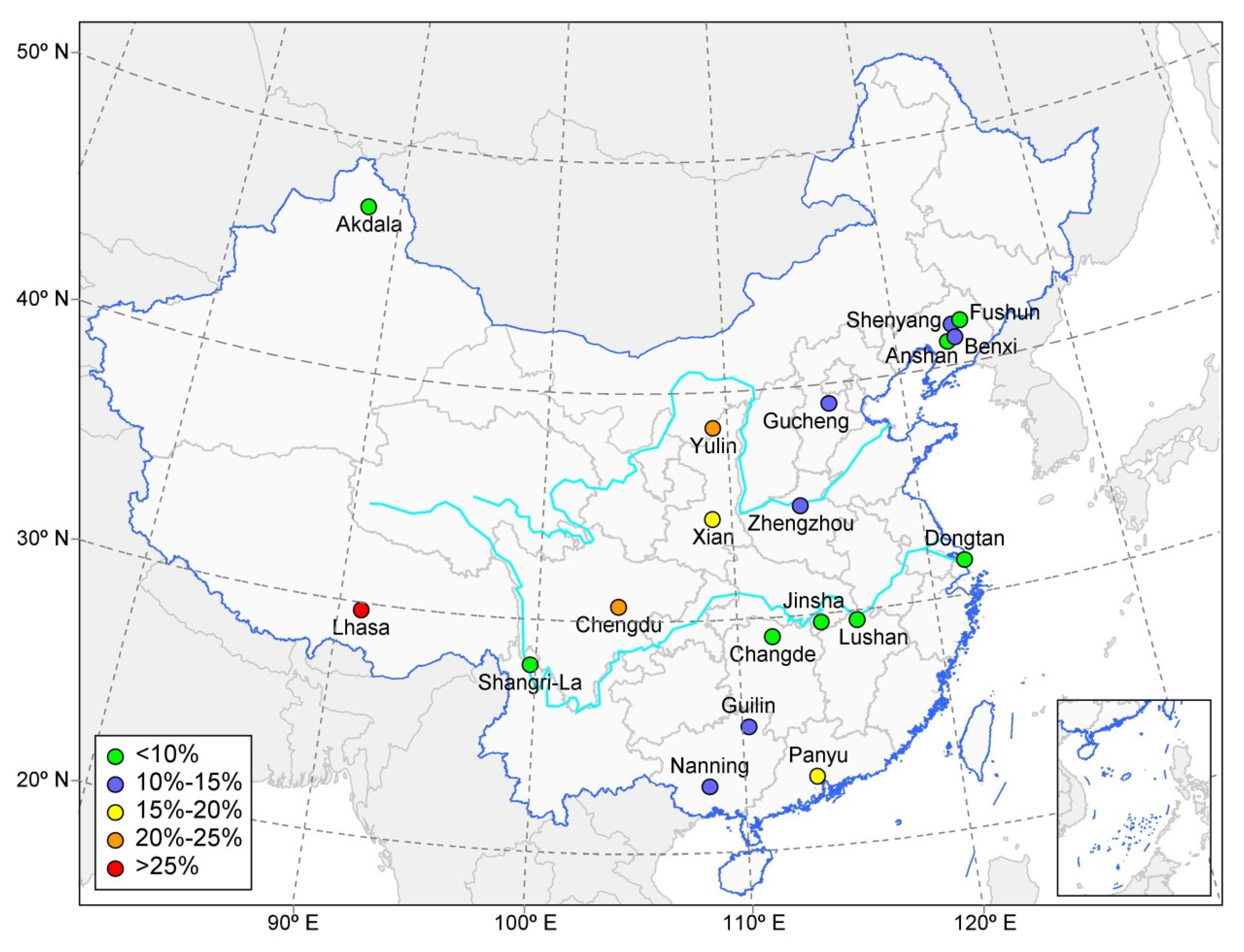


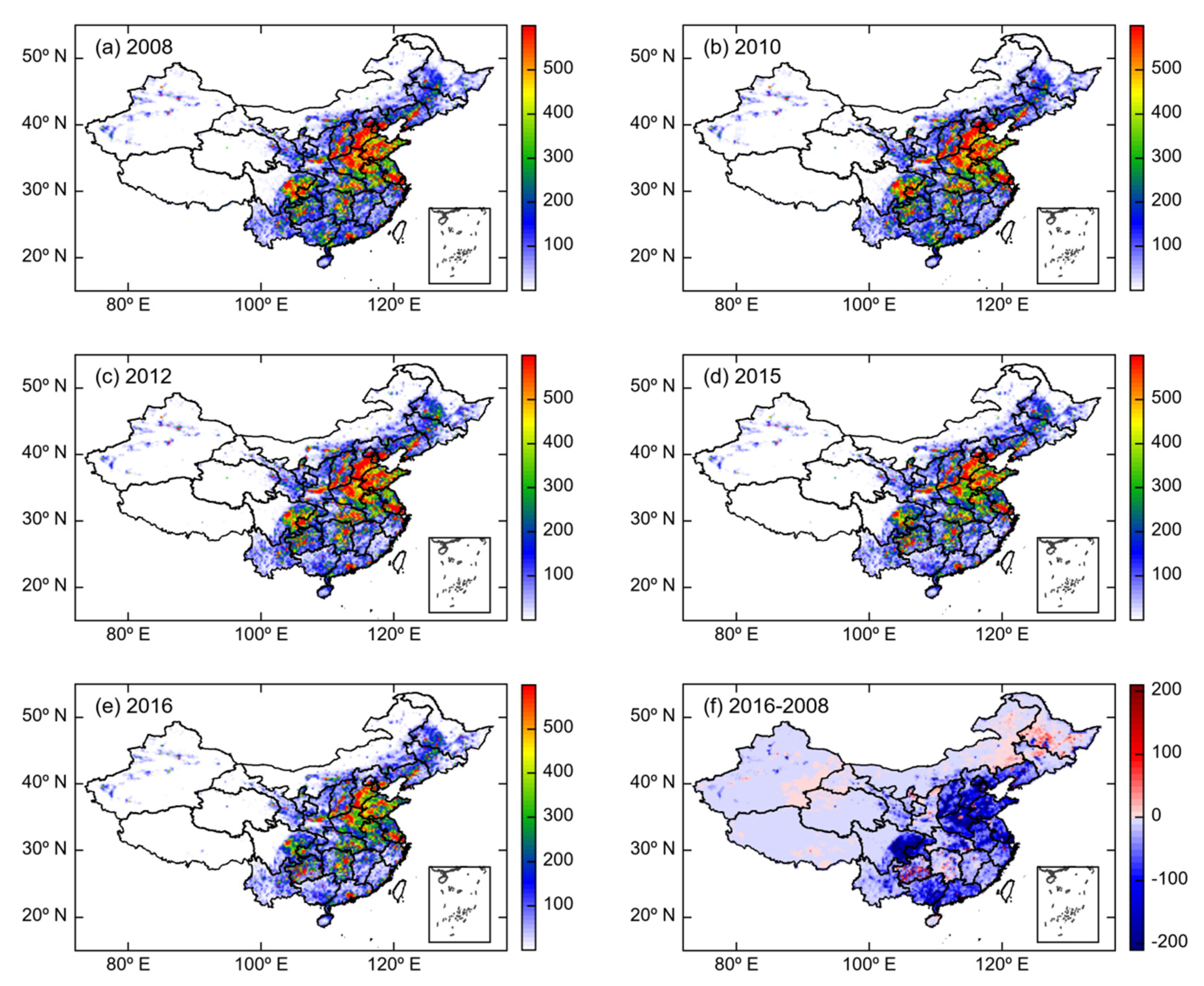
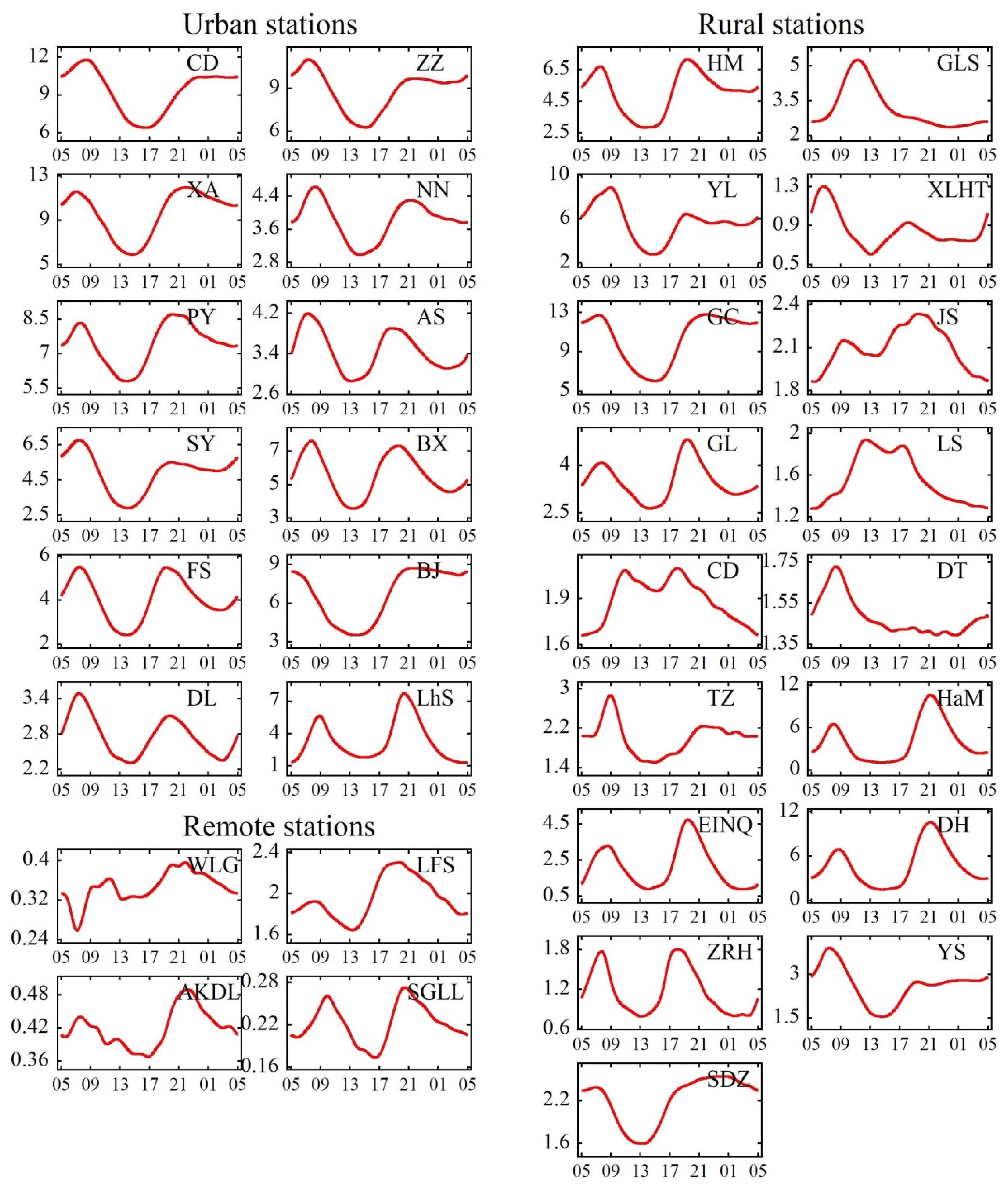
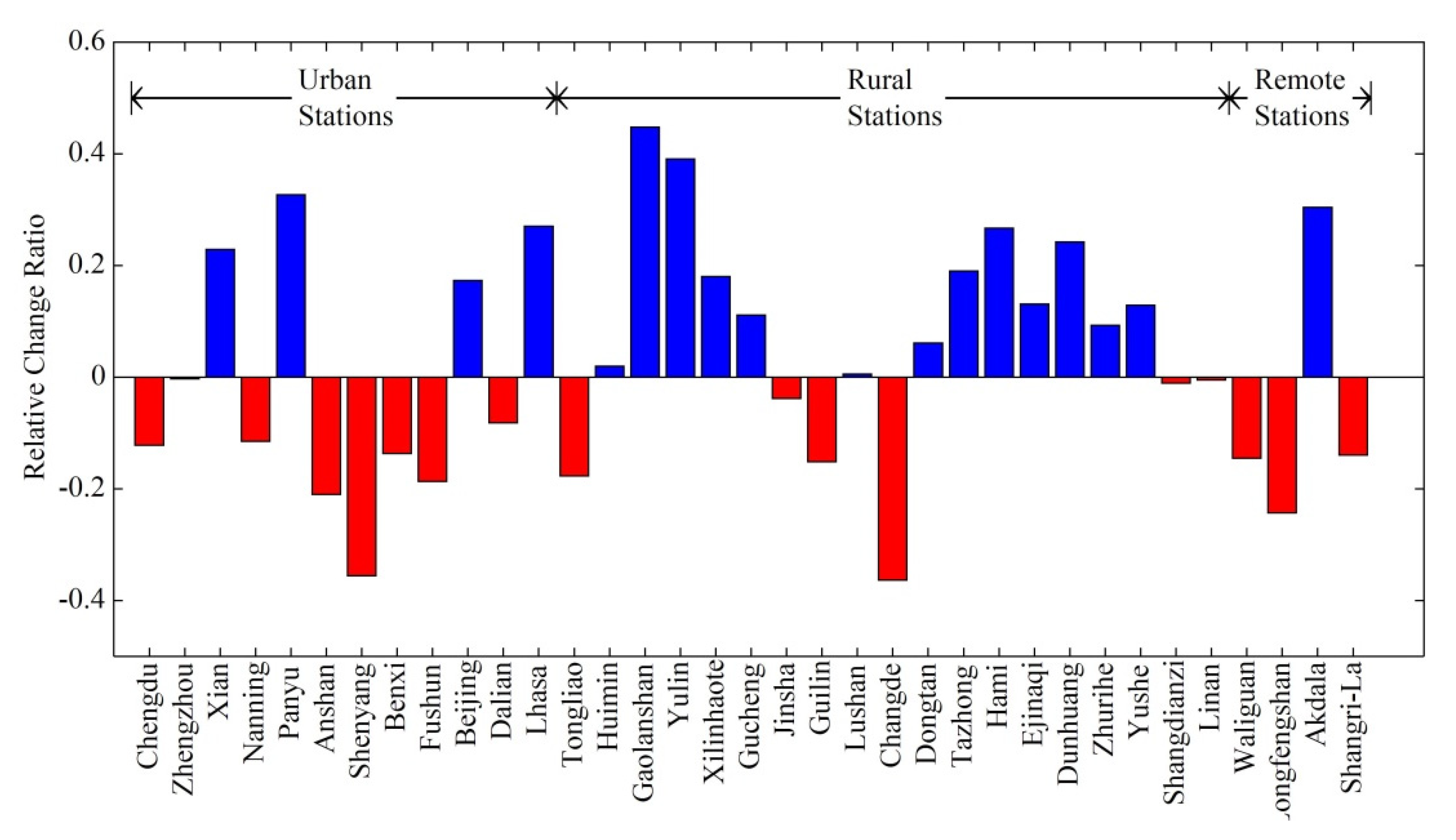
| Stations | Latitude (°N) | Longitude (°E) | Altitude (m) | Type | σ* 1 | BC (2006–2015) | BC (2016) | BC (2017) |
|---|---|---|---|---|---|---|---|---|
| Chengdu (CD) | 30.65 | 104.04 | 496.0 | urban | 14.1 | 9.97 | 4.33 | 7.21 |
| Zhengzhou (ZZ) | 34.78 | 113.68 | 99.0 | urban | 12.3 | 9.59 | 6.86 | 4.88 |
| Xi’an (XA) | 34.43 | 108.97 | 363.0 | urban | 9.4 | 10.36 | 10.47 | —— |
| Nanning (NN) | 22.82 | 108.35 | 84.0 | urban | 13.4 | 4.01 | 2.41 | 2.00 |
| Panyu (PY) | 23.00 | 113.35 | 5.0 | urban | 8.8 | 7.90 | 3.84 | —— |
| Anshan (AS) | 41.05 | 123.00 | 78.3 | urban | 14.4 | 3.66 | 1.95 | 2.24 |
| Shenyang (SY) | 41.76 | 123.41 | 110.0 | urban | 14.4 | 5.29 | —— | —— |
| Benxi (BX) | 41.19 | 123.47 | 185.4 | urban | 14.4 | 6.00 | 6.60 | 4.56 |
| Fushun (FS) | 41.88 | 123.95 | 163.0 | urban | 14.4 | 4.39 | 3.51 | 2.62 |
| Beijing (BJ) | 39.80 | 116.47 | 31.3 | urban | 11.2 | 7.17 | 5.50 | 7.35 |
| Dalian (DL) | 38.90 | 121.63 | 91.5 | urban | 14.4 | 2.94 | —— | 0.73 |
| Lhasa (LhS) | 29.67 | 91.13 | 3663.0 | urban | 8.8 | 3.57 | 3.46 | 3.10 |
| Tongliao (TL) | 43.60 | 122.27 | 178.5 | rural | 14.4 | 3.67 | 3.76 | 3.61 |
| Huimin (HM) | 37.48 | 117.53 | 11.7 | rural | 11.2 | 5.31 | 1.73 | 1.92 |
| Gaolanshan (GLS) | 36.00 | 105.85 | 2161.5 | rural | 7.3 | 3.34 | 3.24 | 2.18 |
| Yulin (YL) | 38.43 | 109.20 | 1135.0 | rural | 7.3 | 6.00 | —— | —— |
| Xilinhaote (XLHT) | 43.95 | 116.12 | 1003.0 | rural | 11.2 | 0.88 | 0.16 | 0.14 |
| Gucheng (GC) | 39.13 | 115.80 | 15.2 | rural | 11.2 | 11.13 | —— | 9.97 |
| Jinsha (JS) | 29.63 | 114.20 | 416.0 | rural | 12.3 | 2.22 | —— | —— |
| Guilin (GL) | 25.32 | 110.30 | 164.4 | rural | 13.4 | 3.67 | 2.75 | 3.14 |
| Lushan (LS) | 29.57 | 115.99 | 1165.0 | rural | 12.3 | 1.65 | 0.55 | 0.43 |
| Changde (CD) | 29.17 | 111.71 | 563.0 | rural | 18 | 2.03 | —— | 2.34 |
| Dongtan (DT) | 31.50 | 121.80 | 10.0 | rural | 12.3 | 1.64 | 1.98 | 2.48 |
| Tazhong (TZ) | 39.00 | 83.67 | 1099.3 | rural | 8.9 | 2.18 | 1.42 | 0.70 |
| Hami (HaM) | 42.82 | 93.52 | 737.2 | rural | 8.9 | 4.35 | 3.02 | 2.69 |
| Ejinaqi (EINQ) | 41.95 | 101.07 | 940.5 | rural | 8.9 | 2.17 | 0.79 | 0.56 |
| Dunhuang (DH) | 40.15 | 94.68 | 1139.0 | rural | 8.9 | 5.00 | 4.50 | 4.43 |
| Zhurihe (ZRH) | 42.40 | 112.90 | 1150.8 | rural | 11.2 | 1.20 | 0.66 | 0.78 |
| Yushe (YS) | 37.07 | 112.98 | 1041.4 | rural | 12.3 | 2.79 | 3.28 | —— |
| Shangdianzi (SDZ) | 40.65 | 117.12 | 293.3 | rural | 11.2 | 2.40 | 2.29 | 1.82 |
| Linan (LA) | 30.30 | 119.73 | 138.6 | rural | 12.3 | 4.14 | 2.74 | 2.43 |
| Waliguan (WLG) | 36.28 | 100.92 | 3816.0 | remote | 14 | 0.38 | 0.32 | 0.31 |
| Longfengshan (LFS) | 44.73 | 127.60 | 330.5 | remote | 14.4 | 2.03 | 0.98 | 1.13 |
| Akdala (AKDL) | 47.12 | 87.97 | 562.0 | remote | 8.9 | 0.45 | 0.41 | 0.45 |
| Shangri-La (SGLL) | 28.02 | 99.73 | 3580.0 | remote | 14 | 0.25 | —— | 0.20 |
© 2020 by the authors. Licensee MDPI, Basel, Switzerland. This article is an open access article distributed under the terms and conditions of the Creative Commons Attribution (CC BY) license (http://creativecommons.org/licenses/by/4.0/).
Share and Cite
Guo, B.; Wang, Y.; Zhang, X.; Che, H.; Ming, J.; Yi, Z. Long-Term Variation of Black Carbon Aerosol in China Based on Revised Aethalometer Monitoring Data. Atmosphere 2020, 11, 684. https://doi.org/10.3390/atmos11070684
Guo B, Wang Y, Zhang X, Che H, Ming J, Yi Z. Long-Term Variation of Black Carbon Aerosol in China Based on Revised Aethalometer Monitoring Data. Atmosphere. 2020; 11(7):684. https://doi.org/10.3390/atmos11070684
Chicago/Turabian StyleGuo, Bin, Yaqiang Wang, Xiaoye Zhang, Huizheng Che, Jing Ming, and Ziwei Yi. 2020. "Long-Term Variation of Black Carbon Aerosol in China Based on Revised Aethalometer Monitoring Data" Atmosphere 11, no. 7: 684. https://doi.org/10.3390/atmos11070684
APA StyleGuo, B., Wang, Y., Zhang, X., Che, H., Ming, J., & Yi, Z. (2020). Long-Term Variation of Black Carbon Aerosol in China Based on Revised Aethalometer Monitoring Data. Atmosphere, 11(7), 684. https://doi.org/10.3390/atmos11070684






